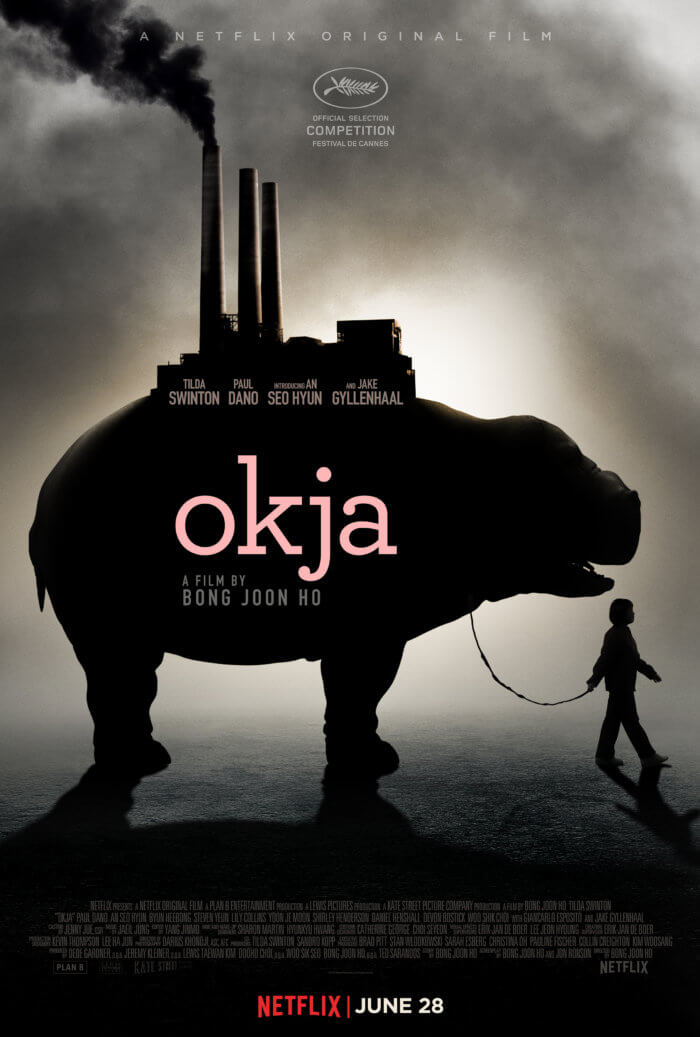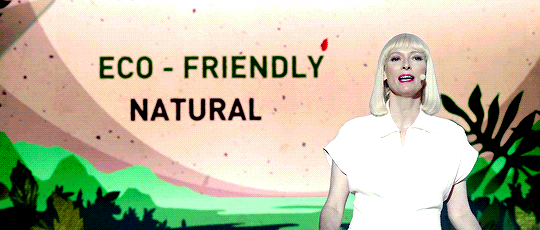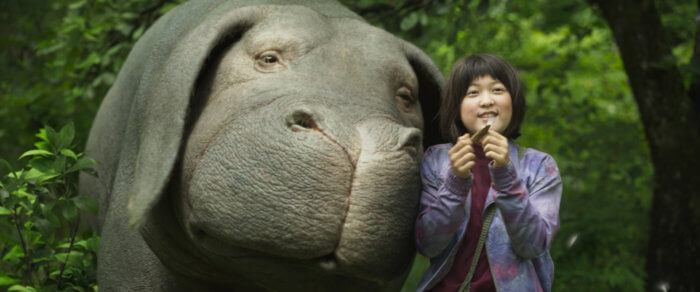
Viewers familiar with Korean director Bong Joon-Ho’s previous films The Host and Snowpiercer know that he mixes action-packed chase scenes with political commentary on environmental catastrophe, social hierarchy, and now with Okja—animal rights. Released by Netflix on June 28, Okja is an indictment of humankind and the lies we believe in order to avoid confronting moral truths, including how we view and treat nonhuman animals. The film was nominated for the Palme d’Or, the highest prize at the Cannes Film Festival; it didn’t win, but this most likely reflects the film establishment’s disdain for Netflix rather than the quality of Okja itself.
Okja: A Super-pig Miracle
In Bong’s drama, Tilda Swinton plays Lucy Mirando, the new CEO of an evil multinational agrochemical company—the Mirando Corporation—that is trying to convince us that it has reclaimed its soul. Lucy’s grandiose plan is to feed the world, heal the planet, and save humanity with her fleet of genetically engineered super-pigs. The last part is a secret. According to Mirando, scientists discovered the first super-pig on a rural farm in Chile. So ethical consumers need not worry, these super-pigs are eco-friendly, non-GMO, and all natural. And for any lingering skeptics, Mirando has enlisted the help of T.V. star Dr. Johnny Wilcox, played by Jake Gyllenhaal, and twenty-six native farmers from around the world to solidify its image as an ethical corporation. Over ten years, these twenty-six farmers will compete to raise the largest and most beautiful super-pig.
Okja, the soon-to-be Mirando super-pig poster child, grew up alongside her human companion Mija, played by Ahn Seo-Hyun, the teenage granddaughter of an old Korean farmer. Okja and Mija are inseparable. They pick fruit together, swim, hike, fish, nap, and scratch each other’s backs.

When the Mirando Corporation takes Okja away, Mija is suddenly exposed to a harsh capital-driven world that regards all animals—even self-aware, cognitively and emotionally complex animals like Okja—as property. Instead of shedding her childhood ideals, Mija rebels against her traditional grandfather and vows to rescue Okja. Along the way, she must navigate a world filled with radical animal activists, self-absorbed T.V. personalities, and cold-blooded capitalists.
A Greenwashed Reality
Okja’s brilliance lies in using an absurd, attention-grabbing platform to speak truths that we’d rather avoid. Swinton’s palpable sarcasm, Gyllenhaal’s over-the-top performance, and Paul Dano’s crew of dogmatic animal activists will make you simultaneously cringe and laugh, ultimately asking, in what reality does Bong live in?
If you watch the first five minutes of Okja and find yourself asking that question, watch Seaworld’s new post-Blackfish orca encounter show, an all-natural, educational, and inspirational exhibit. Sound familiar?
Fortunately, live animal entertainment is becoming obsolete in Hollywood. Okja joins a host of recent movies including The Jungle Book and War for the Planet of the Apes that use realistic computer-generated imagery (CGI) as a safer and more compassionate alternative to animal “actors.” Yet Seaworld and a number of Hollywood animal trainers remain behind the times, subjecting elephants, chimpanzees, and cetaceans, among other animals, to coercive training, cruel tricks, and endless confinement. With CGI on the rise, it’s that much more difficult to justify the use of animals in movies and amusement parks.
And as Bong demonstrates, no amount of corporate rebranding will ever mask the reality of stripping an autonomous nonhuman animal of his or her freedom.

Okja urges us to question the authenticity of buzzwords designed to soothe our consciences—words like humane, welfare, and conservation rendered empty by false, fluffy advertising. Mirando, Monsanto, Seaworld, and Cargill, like most companies with poor environmental and animal welfare records, rely on the type of greenwashing lampooned in Okja in order to stay afloat. Bong suggests that we’re in part responsible for buying into corporate falsehoods. And that may make us as much the butt of his jokes as the corporations themselves. However, his critique doesn’t stop with Madison Avenue. He throws into question another common phrase—“I’m an animal lover.”
The End of Human Dominance
We’re all animal lovers, or so we’d like to think. Our self-image as benevolent masters isn’t so much empty as it is filled with emotionally charged cognitive dissonance, and Okja wants to call attention to that fact. Bong asks us to consider whether our love of animals has more to do with our own egos than any genuine bond or respect for nonhuman others. He implicates all of us in his commentary and refuses to let his audience walk away feeling absolved. Throughout Okja, you’ll see narcissism consume not only Swinton and Gyllenhaal but also some of Bong’s most enlightened animal activists, who relish their own image as undercover heroes.

At the same time, Bong’s incisive commentary strikes deeper than individual narcissism and takes aim at an age-old story humans have been telling themselves for millennia: as the most intelligent and moral beings on this planet, we are the rightful owners of its nonhuman inhabitants. But as Okja points out, that’s a high bar. Most humans don’t meet that intelligence threshold until they’re adolescents, and that doesn’t make them any less valuable as human beings.
Growing Up in an Unjust World
Okja is not simply an animal rights movie. It’s also a coming-of-age story about what happens to our view of animals when we reach that intelligence threshold and become adults. As Mirando kidnaps Okja, Mija’s grandfather presents her with a golden pig:
“In the old days, the elders would give a golden pig to their daughters as a wedding gift,” he says. “Mija, you’re nearly a grown woman now. I don’t like you playing with that pig all day. You should go to town, meet a boy, and—”
Mija cuts him off and throws the pig statue on the ground. For Mija’s grandfather, the choice is clear: Mija either becomes an adult and embraces the thinghood of animals or remains forever a young girl, sentimental and attached to a childhood pet. For Mija, the entire premise is flawed. Throughout the film, she must preserve her compassion in spite of a world ruled by callous adults. And perhaps that makes Mija more of an adult than any other character in the film.
Personhood for Okja
Okja also challenges the tradition of human superiority, demonstrating that she is just as intelligent, empathetic, and selfless as most of the characters in the movie—if not more so. She’s willing to sacrifice her own life for a member of another species. And she’s not a mere exception. Prepare to feel your heart break when you witness the altruism of her fellow super-pigs. In stark contrast stand the Mirando twins: Lucy—an insecure corporate puppet who relies on the intelligence of a double-dealing tactician—and Nancy—a heartless executive. If species hierarchy follows the great chain of being, what does it say about us that the Mirando twins occupy the top rung of human society?
Here Bong raises yet more questions. Who is more human—the insidious Mirando sisters or Okja, an alien-like creature? And does it even matter? If we side with Okja, then how do we redefine humanity and justify our view of these animals as objects?

Bong—by depicting Okja as an amalgam of a dog, a pig, and an elephant—insists that Okja exists beyond the movie screen. As Bong notes in an interview with The Guardian, Okja’s dog-like playfulness and pig-like fate are meant to shine a light on our differential treatment of domestic and food animals, a societal inconsistency as arbitrary and unjust as human supremacy.
Ultimately, Bong holds back from delivering a neat and happy ending. While we come to understand that Okja and her real-life relatives are not property, Mija learns that the outside world never saw Okja as anything more than a golden pig and that until we recognize the fundamental rights of nonhuman animals, business will be business.